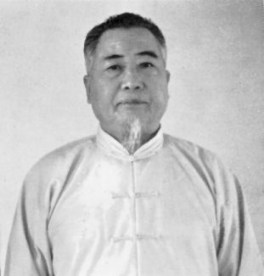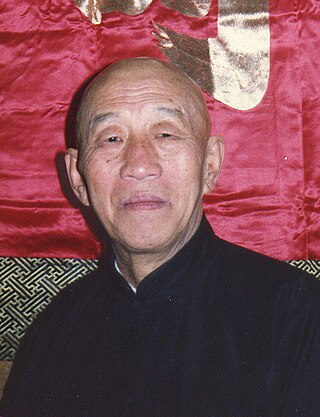Related Research Articles

Neijia is the collective name for the internal Chinese martial arts. It relates to those martial arts occupied with spiritual, mental or qi-related aspects, as opposed to an "external" approach focused on physiological aspects. The distinction dates to the 17th century, but its modern application is due to publications by Sun Lutang, dating to the period of 1915 to 1928. Neijin is developed by using neigong or "internal changes", contrasted with waigong or "external exercises".

Zhang Sanfeng refers to a legendary Chinese Taoist who many believe invented the Chinese martial art tai chi. However, other sources point to earlier versions of tai chi predating Sanfeng. He was purported to have achieved immortality.

Shaolin kung fu, also called Shaolin Wushu, or Shaolin quan, is the largest and most famous style of kung fu. It combines Chan philosophy and martial arts. It was developed in the Shaolin Temple in Henan, China during its 1500-year history. In Chinese folklore there is a saying, "Shaolin kung fu is the best under heaven," which indicates its superiority among martial arts, and "All martial arts under heaven originated from Shaolin," which indicates its influence on other martial arts. The name Shaolin is also used as a brand for the external styles of kung fu. Many styles in southern and northern China use the name Shaolin.

Hung Ga Kuen (Cantonese) or Hongjiaquan (Mandarin) - alternatively shortened as either Hung Ga (洪家) or Hung Kuen (洪拳) - is an ancient southern Chinese martial art, which roots lie in the Northern Shaolin kung fu. During the turn of the 3rd millennium, Hung Ga was one of the most widely practiced styles of kung fu from southern China in the world.

Chinese martial arts, commonly referred to with umbrella terms kung fu, kuoshu or wushu, are multiple fighting styles that have developed over the centuries in Greater China. These fighting styles are often classified according to common traits, identified as "families" of martial arts. Examples of such traits include Shaolinquan (少林拳) physical exercises involving All Other Animals (五形) mimicry or training methods inspired by Old Chinese philosophies, religions and legends. Styles that focus on qi manipulation are called internal, while others that concentrate on improving muscle and cardiovascular fitness are called external. Geographical associations, as in northern and southern, is another popular classification method.

In its broadest sense, Northern Shaolin is the external martial arts of Northern China, referring to those styles from the Northern Shaolin Monastery in Henan and specifically to the style practice by Gù Rǔzhāng, the Sōngshān Shí Lù Shàolínquán (嵩山十路少林拳) / Song Mountain Ten Road Shaolin Boxing.
Shaolin Nam Pai Chuan - also Nam Pai Chuan for short - is a style of Chinese martial arts. It is a relatively modern style, de jure established in 1978 that has mainly proliferated in the UK and from there, to Belgium, France, New Zealand, Canada, Japan, Australia and Malaysia.
There are at least eight distinct lineages of the martial art Wing Chun. These are mostly little-known outside of China, and each has its own history of origin. In the West, Wing Chun's history has become a mix of fact and fiction due to the impacts of early secrecy and modern marketing. Additionally, there are competing genealogies within the same branch or about the same individual teacher.

Huaquan is a Chinese martial art in the changquan family. It is believed to have originated during the Liu Song dynasty near Mount Hua in Shaanxi Province.

Various martial arts have been attributed to or associated with Zhou Tong, the archery teacher of the Song dynasty general Yue Fei. This is because assorted wuxia novels and folk legends portray him as being either a Shaolin monk or a lay disciple of Shaolin. Some of these skills range from mastery of the bow, double swords and Chinese spear to that of Wudang hard qigong, Chuojiao boxing and even magical X-ray eyes. However, the oldest historical record that mentions his name only says he taught archery to Yue Fei. Nothing is ever said about him knowing or teaching a specific style of Chinese martial arts.
Shaolin Prince a.k.a. Death Mask of the Ninja, Shaolin Death Mask, or Iron Fingers of Death, is a 1982 Hong Kong martial arts-action film released by Shaw Brothers and directed by Tang Chia. It is one of the Shaolin Temple themed martial arts films and featured Ti Lung, Derek Yee and Jason Pai Piao.

Chang Dsu Yao was a teacher of the martial arts Meihuaquan and tai chi from Taiwan.

Kuo Lien-ying was one of the most distinguished and revered martial artists of the twentieth century. He brought the Guang Ping Yang tai chi to the United States.

Chen Wangting (1580–1660), courtesy name Chen Zouting, was a Ming dynasty military officer who may have founded Chen-style tai chi, one of the five major styles of the popular Chinese martial art. He reputedly devised his style of tai chi after his retirement following the fall of the Ming dynasty.

Choy Lee Fut is a Chinese martial art and wushu style, founded in 1836 by Chan Heung (陳享). Choy Li Fut was named to honor the Buddhist monk Choy Fook who taught him Choy Gar, and Li Yau-san (李友山) who taught him Li Gar, plus his uncle Chan Yuen-wu (陳遠護), who taught him Hung Kuen, and developed to honor the Buddha and the Shaolin roots of the system.

Doc-Fai Wong is a master of tai chi and the Hung Sing branch of Choy Li Fut kung fu. He was born in 1948 in the Guangdong province of China, specifically, the Wangshan village in the Doumen District of Zhuhai. In April 1960, he and his mother immigrated to San Francisco, California to be reunited with his father. He arrived as a third-generation citizen of the United States of America since both his grandfather and father were already citizens. He sought out his first kung fu teacher - Lau Bun (劉彬), the founder of the first Hung Sing Kwoon of Choy Li Fut in America, after encountering taunting and bullying due to language and ethnic difficulties after his arrival. When Lau Bun died in 1967, Wong Doc-Fai started teaching and opened his first school aged 19.

Wudangquan is a class of Chinese martial arts. In contemporary China, Chinese martial arts styles are generally classified into two major groups: Wudang (Wutang), named after the Wudang Mountains; and Shaolin, named after the Shaolin Monastery. Whereas Shaolin includes many martial art styles, Wudangquan includes only a few arts that use the focused mind to control the body. This typically encompasses tai chi, xingyiquan and baguazhang, but must also include bajiquan and Wudang Sword. Although the name Wudang simply distinguishes the skills, theories and applications of the internal arts from those of the Shaolin styles, it misleadingly suggests these arts originated at the Wudang Mountains. The name Wudang comes from a popular Chinese legend that incorrectly purports the genesis of tai chi and Wudang Sword by an immortal, Taoist hermit named Zhang Sanfeng who lived in the monasteries of Wudang Mountain. Wudangquan is often used synonymously with Neijia, but Neijia is a broader term that also encompasses Qigong, which is not Wudangquan.
Wujiquan, known as the "Ultimate Void Boxing" or "A Rare and Secret Ultimate Void Boxing Skill" and "Mother Art of Tai Chi," is a Chinese martial art. It is a traditional system composed of 36 "Characters" divided into 18 kinds of natural climatic phenomena and 18 of Qi applications.
Sam F.S. Chin is the Grandmaster and Gatekeeper of the martial art called I Liq Chuan, and also known as "the Martial Art of Awareness". Sam Chin developed the grading system and the pedagogical method known as Zhong Xin Dao.
Tibetan White Crane, also known in Cantonese as Bak Hok Pai, is a Chinese martial art with origins in 15th-century Tibetan culture that has developed deep roots in southern China. Tibetan White Crane became so established in Guangdong, Hong Kong and Macau by the twentieth century that it was accepted as a local martial art in that region. From there it has spread around the world.
References
- ↑ "Sifu Wong Kiew-kit". Shaolin-wahnam.org. Retrieved 22 May 2014.
- ↑ "Shaolin Wahnam Lineage". Shaolin.org. Retrieved 22 May 2014.
- ↑ New Straits Times,Jun 15, 1999 Interview with Wong
- ↑ "Certified Instructors of Shaolin Wahnam". Shaolin.org. Retrieved 22 May 2014.
- ↑ Official Website of the World Quigong Federation
- ↑ Chi Kung For Health and Vitality, ISBN 1852309547
- ↑ The Art of Shaolin Kung Fu, ISBN 1852307897
- ↑ The Complete Book of Tai Chi Chuan, ISBN 1852307927
- ↑ The Complete Book of Zen, ISBN 1862042551
- ↑ Introduction to Shaolin Kung Fu, ISBN 0901764531
- ↑ The Complete Book of Chinese Medicine, ISBN 983408790X
- ↑ The Complete Book of Shaolin, ISBN 9834087918
- ↑ Sukhavati: Western Paradise ISBN 9834087934
- ↑ The Art of Chi Kung, ISBN 9780091876579